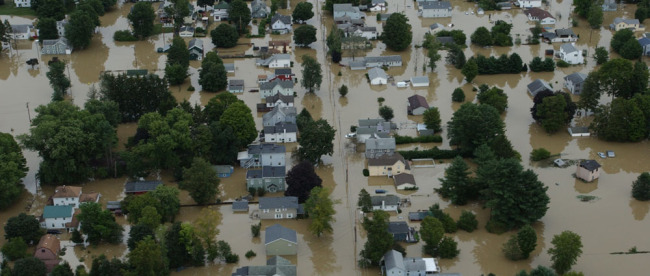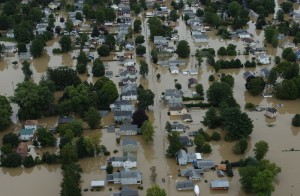A Watershed Moment

By James Hicks.
 Elected officials and the media overwhelmingly presume that flooding is Mother Nature acting alone. In the wake of record flood damage in the northeast after Hurricane Irene and Tropical Storm Lee, policy makers should take account of the fact that particular types of land use and drainage magnify flooding. Rivers flood worse than they would naturally because owners of impervious surfaces—including most roofs, driveways, patios, parking lots, sidewalks, and roads—discharge stormwater, which would otherwise become groundwater, into gutters, curbs, ditches, and storm sewers that channel the water directly to streams and rivers.
Elected officials and the media overwhelmingly presume that flooding is Mother Nature acting alone. In the wake of record flood damage in the northeast after Hurricane Irene and Tropical Storm Lee, policy makers should take account of the fact that particular types of land use and drainage magnify flooding. Rivers flood worse than they would naturally because owners of impervious surfaces—including most roofs, driveways, patios, parking lots, sidewalks, and roads—discharge stormwater, which would otherwise become groundwater, into gutters, curbs, ditches, and storm sewers that channel the water directly to streams and rivers.
Because stormwater carries pollution with it (and, in combined storm and waste sewer systems, feces), Congress in 1987 amended the Clean Water Act so that the EPA and the states could require permits for stormwater discharge from industry, developers, and municipal operators of large storm sewer systems (“MS4s”). To comply with its MS4 discharge permit, a city must administer a local stormwater management program (“SWMP”) in its jurisdiction, including education, planning, illicit discharge detection and elimination, SWPPP enforcement, and “good housekeeping” to reduce stormwater pollution from public operations.
For cities, the most cost-effective “good housekeeping” measures are stormwater best management practices (BMPs) that retain or infiltrate stormwater. If authorized by their state government, cities can fund BMP maintenance by establishing a drainage district in their jurisdiction and imposing a stormwater utility fee on landowners based on their amount of connected impervious surface; and they can encourage landowners to build their own BMPs by offering an exemption to those who do.
The problem and limitation of targeting cities is that a city is invariably a part of a larger watershed or drainage basin. It is unfair for city landowners to pay the cost of catching not only their runoff but also the runoff of landowners upstream of city boundaries. Targeting cities is also inefficient and ineffective: stormwater catchments are far cheaper outside of cities where there is open land, such as along rural roads. Without better rural stormwater management, the rivers will become lakes again with the next big storm, and rural areas will lack the groundwater they need during the next drought.
State legislators can address water quality, water supply, and flood protection by explicitly authorizing basin-wide drainage districts like the Tualatin River Watershed’s Clean Water Services. The EPA or state regulators can remove political barriers by threatening to designate all major dischargers in a drainage basin, encouraging them to form, by inter-municipal agreement, a basin-wide drainage district with a collective discharge permit. With its costs and services distributed among all dischargers in a basin, such a special district could mitigate water pollution, drought, and flooding fairly and cost-effectively.

Thought provoking. Engaging. Mr. Hicks, ever the policy wonk, has nailed it again.
I’m curious how drainage planning can be addressed in areas that rarely see flooding? Like the flooding in upstate New York was either the first time ever or first in a hundred years, so how can semi-rural/rural areas not prone to flooding improve their watershed management?
Thanks for this beautiful information and this site. It is helpful.